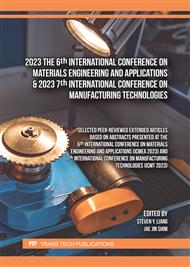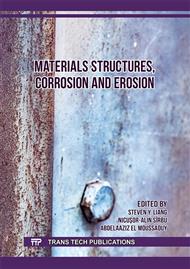[1]
Dejardin, Steeve, Jean-Claude Gelin, and Gérard Michel, "Experimental investigations and numerical analysis for improving knowledge of incremental sheet forming process for sheet metal parts." Journal of Materials Processing Technology 210, no. 2 (2010): 363-369.
DOI: 10.1016/j.jmatprotec.2009.09.025
Google Scholar
[2]
Hirt, Gerhard, Markus Bambach, Wolfgang Bleck, Ulrich Prahl, and Jochen Stollenwerk. "The development of incremental sheet forming from flexible forming to fully integrated production of sheet metal parts." In Advances in Production Technology, pp.117-129. Springer, Cham, 2015.
DOI: 10.1007/978-3-319-12304-2_9
Google Scholar
[3]
Gohil, Ashish, and Bharat Modi. "Review of the effect of process parameters on performance measures in the incremental sheet forming process." Proceedings of the Institution of Mechanical Engineers, Part B: Journal of Engineering Manufacture 235, no. 3 (2021): 303-332.
DOI: 10.1177/0954405420961215
Google Scholar
[4]
Desalegn, Dawit, P. Janaki Ramulu, Dagmawi Hailu, S. Senthil Kumaran, P. Velmurugan, and D. Venkateswarlu. "Formability Analyses on Single Point Incremental Sheet Forming Process on Aluminum 1050." In Materials Science Forum, vol. 969, pp.703-708. Trans Tech Publications Ltd, 2019.
DOI: 10.4028/www.scientific.net/msf.969.703
Google Scholar
[5]
Yeshiwas, Zeradam, and A. Krishniah. "Spiral Toolpath Definition and G-code Generation for Single Point Incremental Forming." Journal of Mechanical Engineering (JMechE) 17, no. 1 (2021): 91-102.
DOI: 10.24191/jmeche.v17i1.15221
Google Scholar
[6]
Esmaeilpour, R., F. Pourboghrat, H. Kim, and T. Park. "Finite Element Analysis of Single Point Incremental Forming (SPIF) of Aluminum 7075 Using Different Types of Toolpaths." In IOP Conference Series: Materials Science and Engineering, vol. 521, no. 1, p.012012. IOP Publishing, 2019.
DOI: 10.1088/1757-899x/521/1/012012
Google Scholar
[7]
Young, D., and J. Jeswiet. "Forming limit diagrams for single point incremental forming of aluminum sheet." Proc. of the Institution of Mechanical Engineers Part B: Journal of Engineering Manufacture 219, no. 4 (2005): 359-364.
DOI: 10.1243/095440505x32210
Google Scholar
[8]
Bambach, M. "A geometrical model of the kinematics of incremental sheet forming for the prediction of membrane strains and sheet thickness." Journal of Materials Processing Technology 210, no. 12 (2010): 1562-1573.
DOI: 10.1016/j.jmatprotec.2010.05.003
Google Scholar



